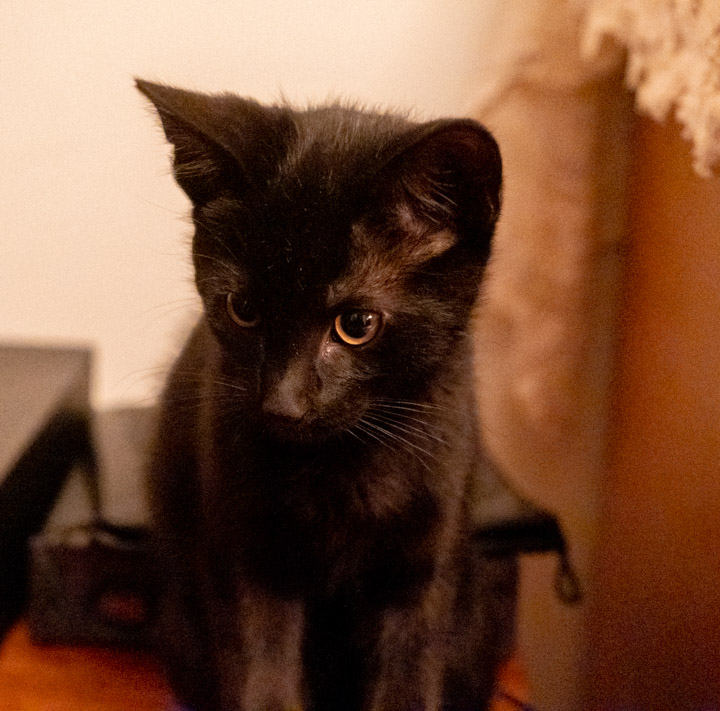
[This fragment is available in an audio version.]
Months into the cold wet Pacific-Northwest Dark Season and our cat, a charming 4-year-old calico, has been bored and fretful. The obvious solution: Get her a kitten! Easier said than done, let me tell ya. But it’s done. The little feline fluffball’s name is Thorn, spelt “þ”. More on that below.
This announcement has been delayed because obviously one must have pictures and little þ is a challenge to photograph. But, finally…
We’ve wanted a kitten for a long time. When we acquired our current cat, a one-year-old rescue who’d already had kittens, they discouraged us from adopting two at a time: “She’s fierce, and mean to other cats” they said. “If you must get another, wait a couple of years then get a male kitten so she can dominate it.”
But in these plague times, kittens are hard to come by. Lauren haunted the SPCA sites of everywhere within four hours’ drive and came up empty, empty, empty. We were seriously considering dropping thousands for a purebred — we had a Bengal once and she worked out great, but we’d really rather rescue.
Anyhow, a week ago Sunday Lauren ran across this little guy on Kijiji, which is a Canadian Craigslist kind of thing. His owner was quite concerned about the quality of home and invited applicants to write about themselves. We sent a picture of the current cat saying “This will be his big sister” and that seemed to do the trick.
Anna was her name, she had a big apartment overlooking False Creek and a badly broken ankle in a huge cast, with more surgery scheduled. And the kitten needed his next vet visit for shots and so on. So I could see why she had to let him go. Thanks, Anna!
That name · By tradition, our cats have had typographical names: Bodoni, Marlowe, Rune, and the current calico is Tilde, spelt “~”. We’ve enjoyed the one-character-ness, and were searching for another (“umlaut” was considered) and then came across þ, the letter Thorn, which was common in lots of old northern European languages notably including Old and Middle English, and survives in Icelandic. It’s “th” basically; usually (but not always) the voiceless flavor as in “thirst”, not voiced as in “other”. Arabic, by the way, has two completely separate letters for these two sounds.
Since this is a proper noun it’d be more orthographically correct to use capital Thorn, “Þ”, but we improperly prefer the lower-case þ.
How it’s going · þ’s eleven weeks old as we write, which means tiny, skinny, and silly; all ears and fluff and bounce. He’s so absurdly light that ~, who’s actually a pretty small cat, seems huge, ponderous to pick up.
The pictures here are deceiving because they omit to mention his pencil-thin legs, bulgy belly, and rat-like tail. Which is OK because he’ll grow out of those; his paws are already big so I’m encouraging ~ to establish dominance now before he’s twice her size.
Fortunately, they get along fine. The mission — addressing ~’s Seasonal Affective Disorder — has been accomplished. It took a couple of days and a careful, gradual introduction, but now they play lots every day. He’s got no fear and ambushes ~ with a vigorous spring-and-pounce (he has to pounce up to reach her) and doesn’t seem to mind when she slaps him around for it. Occasionally she’ll pounce back, she’s so much heavier you can hear the air whooshing out of the kitten when she lands. It doesn’t discourage him.
No kitten was ever smart, but þ’s head seems a little less empty than average. He’ll regularly surprise ~ by sneaking around behind something where she’s not looking. You want a smart cat, get a moggie, which þ definitely is.
Those photos · This is about the blackest animal I’ve ever seen, any species; not a single white hair, nose to tail. Our house lighting, outside the kitchen, tends to the soft, and the furnishings towards dark colors. And of course he never stands still for the camera.
But this evening there he was stretched out on the stereo, to be precise on the Benchmark USB DAC, which I leave on and is thus pleasantly warm.
Thank goodness for modern cameras that do well at ISO3200, for lenses with image stabilization, for the immensely data-rich Fujifilm RAW files, and for Lightroom’s ability to add light gracefully.
By the way, þ is not a digital-audio exclusivist, here he is shortly after discovering that the thing on the record player was going round and round, plotting how to get inside and kill it.
Life is a little more interesting and more cheerful around the house. Every little bit helps, this winter.
Comment feed for ongoing:
From: Glen Ditchfield (Feb 23 2021, at 07:41)
“Arabic, by the way, has two completely separate letters for these two sounds.”
Well, so does Icelandic: the letter Eth (Đ, đ) is the voiced equivalent. There's a Wikipedia page ...
[link]
From: Pete Forman (Feb 23 2021, at 16:22)
þ was current in English at the advent of printing. Early fonts did not include it and y was substituted. Hence modern affectations such as ye olde shoppe which originally would have been þe olde shoppe and properly now should be the old shop.
[link]
From: Jeff Jacob (Feb 23 2021, at 16:45)
I'm curious what your vet has on file. I'd love to hear you explain alt 0222 to a vet tech. Þ þ
[link]
From: Rob (Feb 27 2021, at 19:08)
Please tell me that's Immigrant Song on the turntable.
https://youtu.be/6mp24rBZi_4
[link]